Vegetable Research
1. Improvement of vegetable varieties
(1) Legumes and vegetables
1. Pea ‘Taichung No. 14’:
Named in 1987, it is a tender bean species, semi-dwarf, with white flowers and single flowers. It also has excellent characteristics such as resistance to powdery mildew, high yield, large pods, and large grains.
2. Pea 'Taichung No. 15':
Named in 1992, the variety rights were obtained in 1994. It is a leaf variety with white flowers, white seeds, and black hilum. It has excellent characteristics such as resistance to powdery mildew, high yield, and enlarged bean seedlings.
3. Phaseolus vulgaris 'Taichung No. 2':
named in 1993 and obtained the variety right in 1994. It is an extremely early-growing ugly bean variety. It takes 30 days from sowing to flowering. The tender pods can be harvested 8-10 days after flowering. The tender pods have no tendons. Silk back seam.
4. Phaseolus vulgaris ‘Taichung No. 3’:
Named in 1994 and obtained the variety right in 1996. It is a mid-early-growing pink bean variety. Harvesting can begin 63 days after sowing. The young pods do not have ribs and back seams.
5. Phaseolus vulgaris ‘Taichung No. 4’:
Named in 1995 and obtained the variety right in 1996. It is an early-growing and sensitive bean variety that can be harvested 50 days after sowing. It is tender and has no tendons or back seams.
6. Phaseolus vulgaris ‘Taichung No. 5’:
Named in 1998, the variety rights were obtained in 102. It is a mid-early-growing pink bean variety. Harvesting can begin 63 days after sowing. The young pods do not have ribs and back seams, and the yield is large.
7. Sugar snap pea ‘Taichung No. 16’:
Named in 1998, the variety right was obtained in 102. It is a fresh edible tender pod variety with trailing nature and white flowers. It has the characteristics of powdery mildew resistance, vigorous growth, beautiful tender pods, high yield and excellent quality.
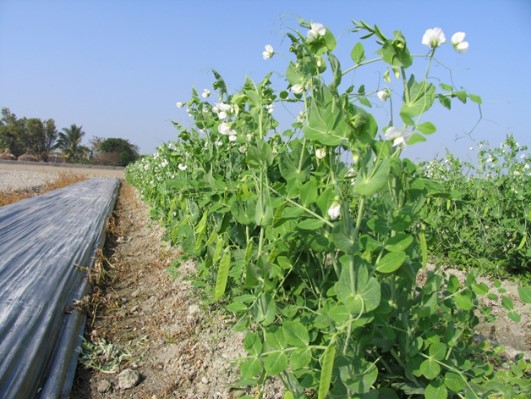
▲ Sugar snap pea ‘Taichung No. 16’
8. Phaseolus vulgaris 'Taichung No. 6':
Named in 107, and obtained the variety right in 108. It is a dwarf variety that can be used for both fresh pod freezing and processing. It can be harvested 55-65 days after sowing. The fresh pods have no tendons, are dark green in color, and are highly sweet.
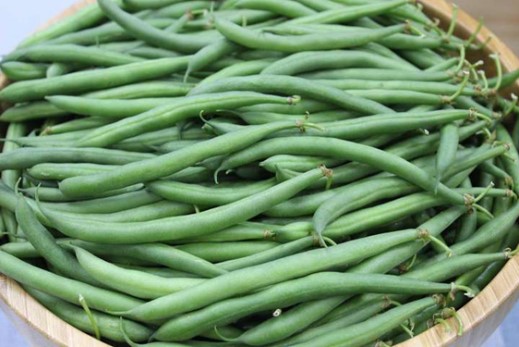
▲ Phaseolus vulgaris 'Taichung No. 6'
9. Sugar snap pea 'Taichung No. 17':
Named in 109 and obtained the variety right in 110. It is a sweet pea species for fresh consumption. It has creeping nature, white flowers, powdery mildew resistance, vigorous growth, beautiful pods, high yield and excellent quality. characteristic.。
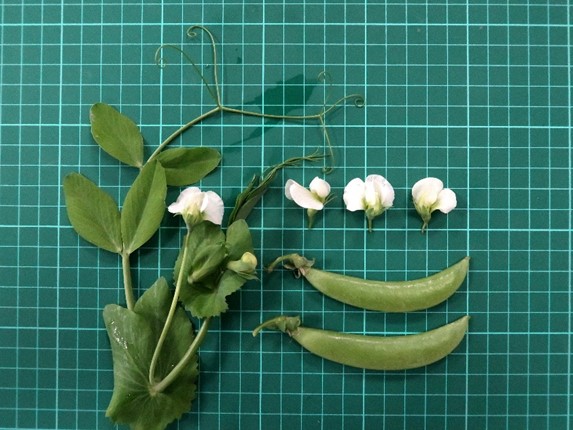
▲ Sugar snap pea 'Taichung No. 17'
(2) Cruciferous vegetables
1. Leaf radish ‘Taichung No. 1’:
named in 1993 and obtained the variety right in 1994. It has excellent characteristics such as heat resistance, moisture resistance, rapid growth and high yield. It has no fuzz on the leaves, has a weak spicy taste, and is of excellent quality.
2. Rapeseed ‘Taichung No. 3’:
Named in 1994, the variety right was obtained in 1995. It can be planted on flat land all year round. It can be harvested about 28 days after sowing in net rooms and open fields in summer and 35-42 days after sowing in winter.
3. Cabbage ‘Taichung No. 1’:
Named and obtained the variety rights in 1996, it is a first-generation hybrid medium-growing variety. It is heat-resistant and can form balls in summer, but is not tolerant to moisture. In autumn and winter, the balls are large and the yield is high. Bolting is easy at low temperatures. Harvesting takes about 66 days after planting in summer and about 71 days in winter.
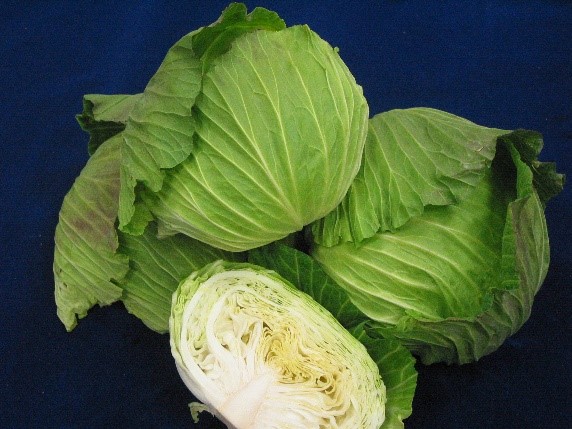
▲ Cabbage ‘Taichung No. 1’
4. Chinese Kale ‘Taichung No. 1’:
It has been named and obtained the variety rights for 100 years. It is a fixed variety with characteristics such as small leaves, early bolting, neat flower sprouts, large flower diameter, high yield per plant, and excellent quality.
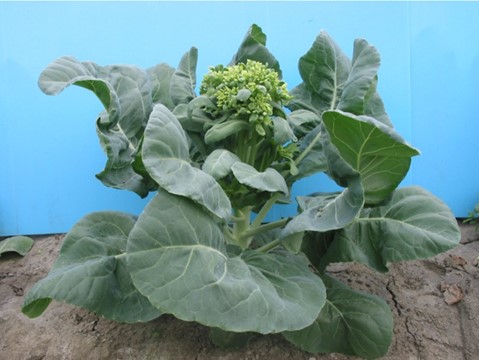
▲ Chinese Kale ‘Taichung No. 1’
5. Cabbage ‘Taichung No. 2’:
Named in 101 and obtained the variety rights in 102, it is a medium-early hybrid variety with fluffy leaves, sweet taste and low fiber, and does not suffer from top fever caused by high temperature and calcium deficiency. It has excellent heat resistance and can be planted on flat ground from April to October.
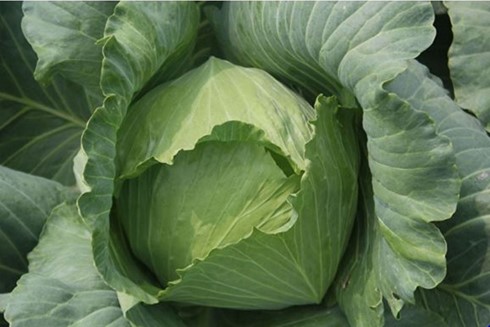
▲ Cabbage ‘Taichung No. 2’
6. Radish ‘Taichung No. 2’:
Named in 104 and obtained the variety right in 106. It belongs to the plate-leaf species and is an open-pollinated variety. It is medium-growing, with a root length of 25 cm, a root width of 7 cm, and a root weight of 675 grams. There are very few smooth fibrous roots and medium bolting.
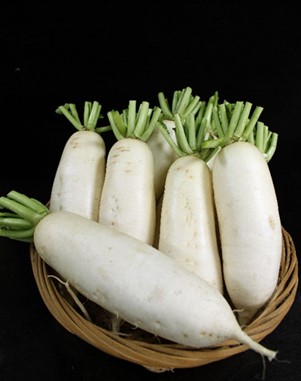
▲ Radish ‘Taichung No. 2’
7. Chinese Kale ‘Taichung No. 2’:
Named in 106 and obtained the variety right in 107. It is a first-generation hybrid variety with both leaves and sprouts. It has white flowers, strong self-incompatibility, easy bolting, and strong heat resistance.
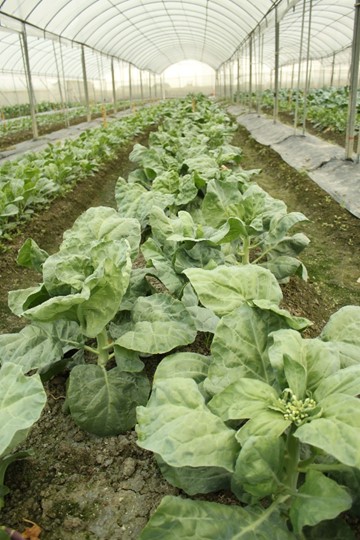
▲ Chinese Kale ‘Taichung No. 2’
8. Cabbage ‘Taichung No. 3’:
Named in 111, it is a round-shaped cabbage and belongs to the first generation hybrid (F1). The leaf balls are light green and spherical, with an average ball weight of 616.2 grams. The balls are crisp and tender, and have strong storage and transportation resistance. The plants are heat-tolerant and resistant to yellow leaf disease.
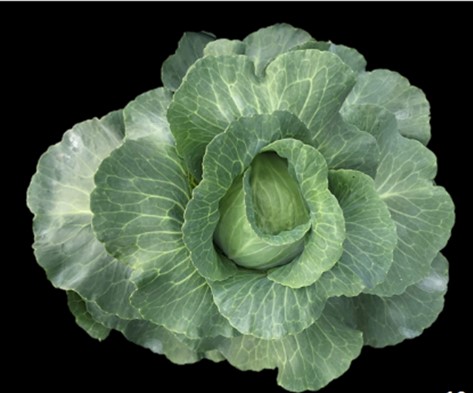
▲ Cabbage ‘Taichung No. 3’
(3) Solanaceous vegetables:
1. Tomato ‘Taichung WorldVeg No. 11’:
Named in 108 and obtained the variety right in 110, it is a first-generation hybrid variety with medium-sized fruit, light green shoulder and fruit color, red fruit color and flesh color when mature, and It is hard, matures early, and has three anti-Yellow Leaf Roll Virus genes, Ty1, Ty3 and Ty2.
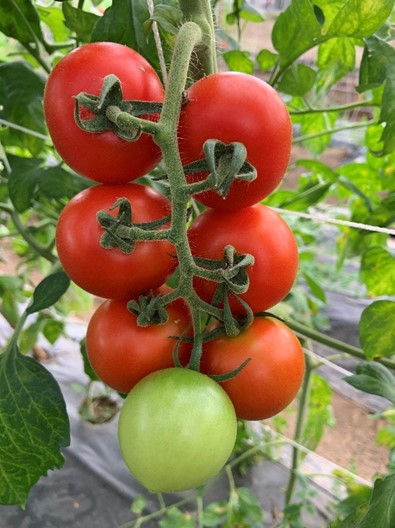
▲ Tomato ‘Taichung WorldVeg No. 11’
2. Pepper ‘Taichung WorldVeg No. 1’:
Named in 110 years and obtained variety rights in 111 years. Hybrid breed. The plant type is intermediate, with medium branching. Ripe fruits are red, with an average fruit weight of about 150 g, 3-4 ventricles, and a smooth fruit surface. The fruit tip is concave and the fruit surface has no grooves. The fruiting concentration is in the middle and the fruiting posture is downward. Resistant to tomato mosaic virus and potato virus Y, moderately susceptible to pepper vein mottle virus and moderately resistant to pepper blight (PC race1).
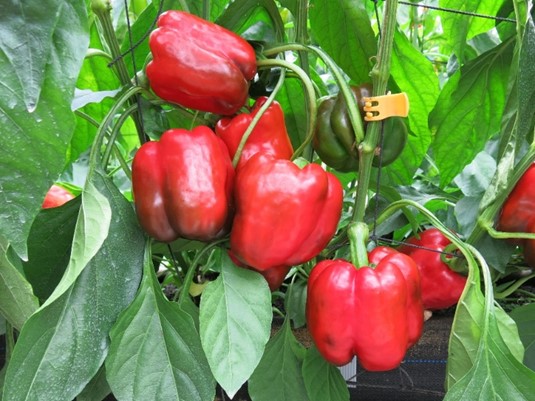
▲ Pepper ‘Taichung WorldVeg No. 1’
3. Sweet pepper ‘Taichung Yashu No. 2’:
Named in 111 and obtained the variety right in 112. The fruit is a square sweet pepper that turns from green to yellow. The fruit is medium-sized and weighs 160-210g. The fruit shape is flat at the pedicel junction, the fruit tip is concave, the fruit stem length is medium, the fruit surface has no grooves, and the fruit cortex is soft. The fruiting concentration is in the middle, the fruit posture is downward, the fruits are not easy to fall off, and there are many fruits. Resistant to pepper vein mottle virus, potato virus Y and bacterial spot disease, moderately resistant to epidemic diseases.
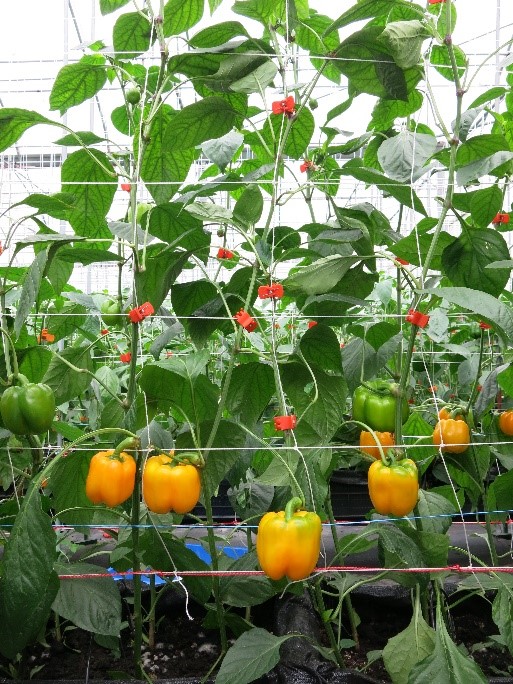
▲ Sweet pepper ‘Taichung Yashu No. 2’
(4) Other vegetables
1. Celery ‘Taichung No. 1’:
Named in 105 and obtained the variety right in 106. It is a local celery, celery is used for pedicels, and it is an open-pollinated variety. The plant shape is upright, with a plant height of about 63 cm, and an average plant weight of 105 g. The ridges are obvious; the aroma is strong and the stems are easy to bolt.
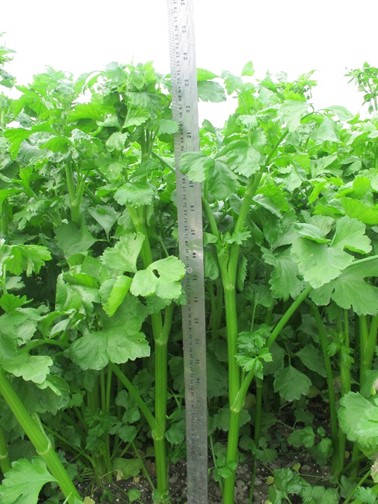
▲ Celery ‘Taichung No. 1’
2. Melon ‘Taichung No. 2’:
Named in 110 years, it has male flowers and hermaphrodite flowers on the same plant. It has good plant growth, large and dark green leaves, neatly blooming hermaphrodite flowers in summer, high fruit setting rate, regular and high-quality fruits, and net The grains are thick and dense, the yield and sugar content are both high, and the shelf life is long.
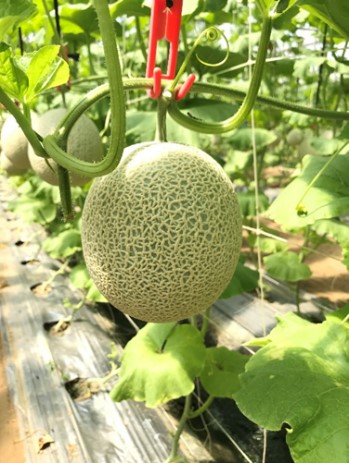
▲ Melon ‘Taichung No. 2’
2. Improvement of cultivation technology
(1) Research on the utilization of non-woven fabrics:
In 1990, non-woven fabrics were developed for storage and packaging of fruits and vegetables after harvesting. In beans and tomatoes, the storage life can be increased by 5-10 days. In addition, non-woven fabrics with a basis weight of 14-18 grams/square meter are used to cover cabbage sprouts, and non-woven fabrics with a basis weight of 18 grams/square meter are used to cover green garlic, which can improve the quality and reduce the crude fiber content, especially to reduce pest damage and ensure the safety of vegetable consumption. .
(2) Eggplant V-shaped pruning technology:
Compared with traditional pruning methods, the eggplant V-shaped pruning technology established in 1992 can improve yield and quality, and is more convenient for field operations. It has been widely used by farmers.
(3) Reuse of old media in facilities:
Cultivation operators must replace (new) cultivation media approximately every 2-3 years, which poses the largest cost burden. In 1997, research and development of technology for reusing old media after facility vegetable and fruit cultivation can reduce farmers’ costs. The cost of purchasing new media is about 200,000-400,000 yuan/hectare, which solves the problems of high cost of purchasing media and reducing the amount of discarded old media.
(4) Garlic bulbs promote the establishment of a commercial production model for cultivation:
In 1997, Hemei varieties or large black varieties were used. The garlic seeds were selected as high-spherical garlic bulbs. The garlic cloves should be moderate, with a small number of cloves, neat, solid, and free of infected nematodes and toxin diseases. . Refrigeration of garlic seeds at 10°C for 2-3 weeks before planting can promote early germination of garlic and delay the planting period to early October.
(5) Research and development of environment-friendly production technology for native specialty crops:
From 106 to 110 years, we provided guidance on organic vegetable cultivation technology for the Wujie and Wanfeng tribes in Renai Township, Nantou County, assisted the tribesmen in soil fertility analysis and water quality testing, introduced environmental monitoring instruments, and investigated The correlation between microclimate changes in the cultivation environment and the occurrence of pests and diseases, and establishing an early warning mechanism for pests and diseases. We also provided guidance on cultivation techniques for summer organic cabbage and tomatoes, including variety selection, comprehensive organic pest control, and the introduction of microbial preparations - Bacillus amyloliquefaciens application technology. We successfully established the cultivation and management technology of summer organic cabbage and tomatoes for native tribes.
(6) Improvement of regional vegetable post-harvest treatment technologies:
Develop post-harvest treatment technologies for various vegetable crops from 103 to 110 years, including:
- After harvesting, young ginger can be refrigerated at 5°C and packaged in a single piece of vacuum packaging to keep its appearance smooth and non-yellowing. When stored in a non-woven PE bag, it can last up to 16 days before it begins to decay; the germination effect of seed ginger is estimated at 1% The germination effect is best when soaked in citric acid, packaged in PE bags, and placed at 30°C.
- The storage method of taro is stratification storage at 5℃, which has better effect. Using coconut fiber as the stratification medium can store taro for up to 6 weeks.
- The products of asparagus that are air-cooled indoors at 5℃ for 4 hours and pre-cooled by bottom layer water absorption have better quality. In addition, the products are stored in OPP plastic bags and stored at 5℃. Compared with the unpackaged control group, the quality of the products is better. Post-harvest quality decreases less, and the commercial value of garden products after storage for 2 days is still good.
- It is recommended to remove the calyces and pods of sweet peas and pre-cool them to 5℃ with a 95% RH pressure difference as the appropriate post-harvest treatment method for sweet peas.
- During summer cultivation of cabbage, reducing the amount of nitrogen fertilizer applied to 20 grams/square meter, harvesting with outer leaves and storing at 3~5℃ can effectively reduce the incidence of black spot disease. In addition, correlation analysis was conducted between plants with different degrees of black spot disease and their plant nitrogen content, nutrient elements, H2O2 and MDA content. The results showed that hydrogen peroxide and malondialdehyde showed a high quadratic positive correlation (R2=0.952 and 0.852). There is a negative correlation with ammonium nitrogen (R2=0.884), but there is no significant correlation with the contents of total nitrogen, nitrate nitrogen, phosphorus, potassium, sodium, calcium and magnesium. It can be speculated that oxidative stress damage to cells is responsible for causing black spot disease. cause.
3. Facility construction
(1) Construction of vegetable greenhouse:
Facility medium cultivation originated around 1981. This site built a powerful vegetable greenhouse in 100, providing a field for the development and observation of soilless cultivation, microbial liquid fertilizer and other technologies.
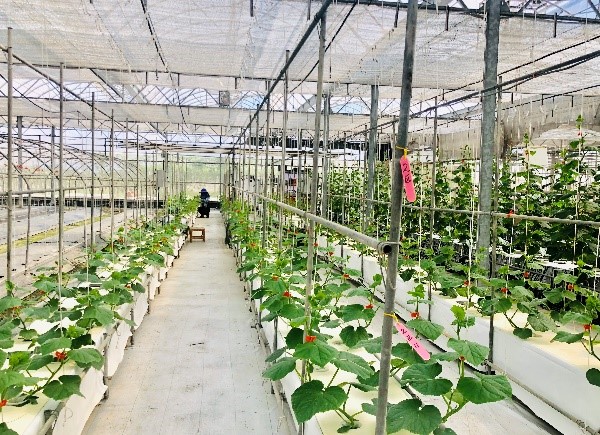
▲ Construction of vegetable greenhouse
(2) Vegetable mountain-shaped greenhouse construction:
"Construct a greenhouse facility demonstration site", build 2 mountain-shaped greenhouses, and provide course research and practice related to facility cultivation in a standardized and standardized manner.
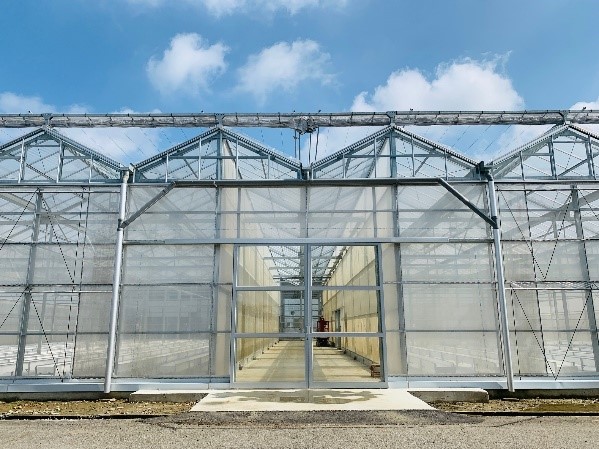
▲ Vegetable mountain-shaped greenhouse construction
(3) Construction of smart environmentally controlled greenhouse for crop breeding:
mountain-shaped steel frame structure. The greenhouse is mainly used for cultivation experiments. It has 2 vegetable cultivation greenhouses and 8 experimental greenhouses with environmental control power.
